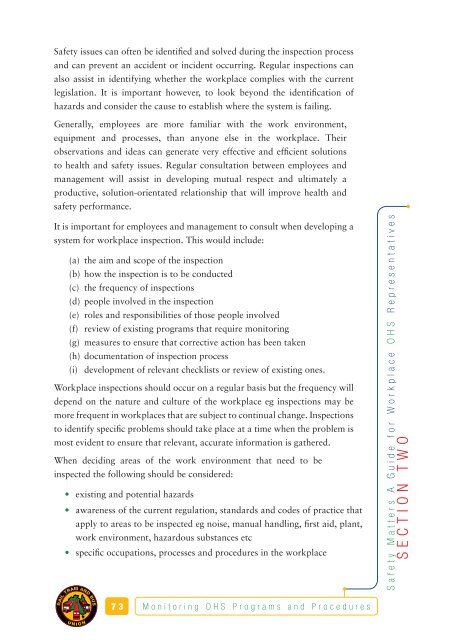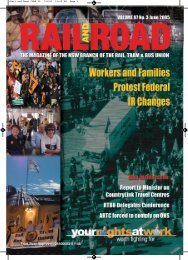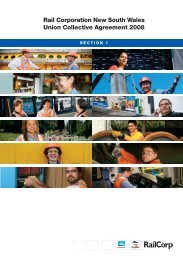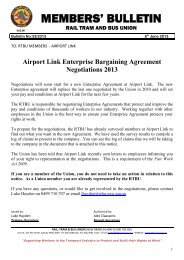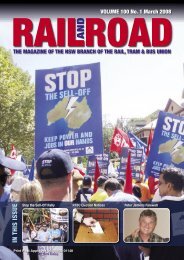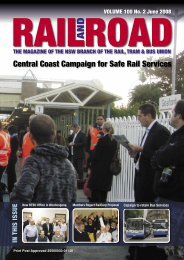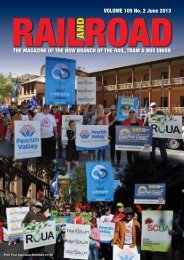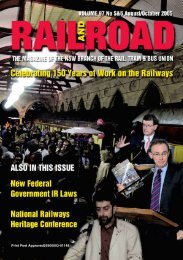Safety Matters - Rail, Tram and Bus Union of NSW
Safety Matters - Rail, Tram and Bus Union of NSW
Safety Matters - Rail, Tram and Bus Union of NSW
You also want an ePaper? Increase the reach of your titles
YUMPU automatically turns print PDFs into web optimized ePapers that Google loves.
<strong>Safety</strong> issues can <strong>of</strong>ten be identified <strong>and</strong> solved during the inspection process<br />
<strong>and</strong> can prevent an accident or incident occurring. Regular inspections can<br />
also assist in identifying whether the workplace complies with the current<br />
legislation. It is important however, to look beyond the identification <strong>of</strong><br />
hazards <strong>and</strong> consider the cause to establish where the system is failing.<br />
Generally, employees are more familiar with the work environment,<br />
equipment <strong>and</strong> processes, than anyone else in the workplace. Their<br />
observations <strong>and</strong> ideas can generate very effective <strong>and</strong> efficient solutions<br />
to health <strong>and</strong> safety issues. Regular consultation between employees <strong>and</strong><br />
management will assist in developing mutual respect <strong>and</strong> ultimately a<br />
productive, solution-orientated relationship that will improve health <strong>and</strong><br />
safety performance.<br />
It is important for employees <strong>and</strong> management to consult when developing a<br />
system for workplace inspection. This would include:<br />
(a) the aim <strong>and</strong> scope <strong>of</strong> the inspection<br />
(b) how the inspection is to be conducted<br />
(c) the frequency <strong>of</strong> inspections<br />
(d) people involved in the inspection<br />
(e) roles <strong>and</strong> responsibilities <strong>of</strong> those people involved<br />
(f) review <strong>of</strong> existing programs that require monitoring<br />
(g) measures to ensure that corrective action has been taken<br />
(h) documentation <strong>of</strong> inspection process<br />
(i) development <strong>of</strong> relevant checklists or review <strong>of</strong> existing ones.<br />
Workplace inspections should occur on a regular basis but the frequency will<br />
depend on the nature <strong>and</strong> culture <strong>of</strong> the workplace eg inspections may be<br />
more frequent in workplaces that are subject to continual change. Inspections<br />
to identify specific problems should take place at a time when the problem is<br />
most evident to ensure that relevant, accurate information is gathered.<br />
When deciding areas <strong>of</strong> the work environment that need to be<br />
inspected the following should be considered:<br />
• existing <strong>and</strong> potential hazards<br />
• awareness <strong>of</strong> the current regulation, st<strong>and</strong>ards <strong>and</strong> codes <strong>of</strong> practice that<br />
apply to areas to be inspected eg noise, manual h<strong>and</strong>ling, first aid, plant,<br />
work environment, hazardous substances etc<br />
• specific occupations, processes <strong>and</strong> procedures in the workplace<br />
<strong>Safety</strong> <strong>Matters</strong> A Guide for Workplace OHS Representatives<br />
SECTION TWO<br />
RAIL<br />
TRAM AND BUS<br />
73<br />
Monitoring OHS Programs <strong>and</strong> Procedures<br />
U N<br />
I O N


